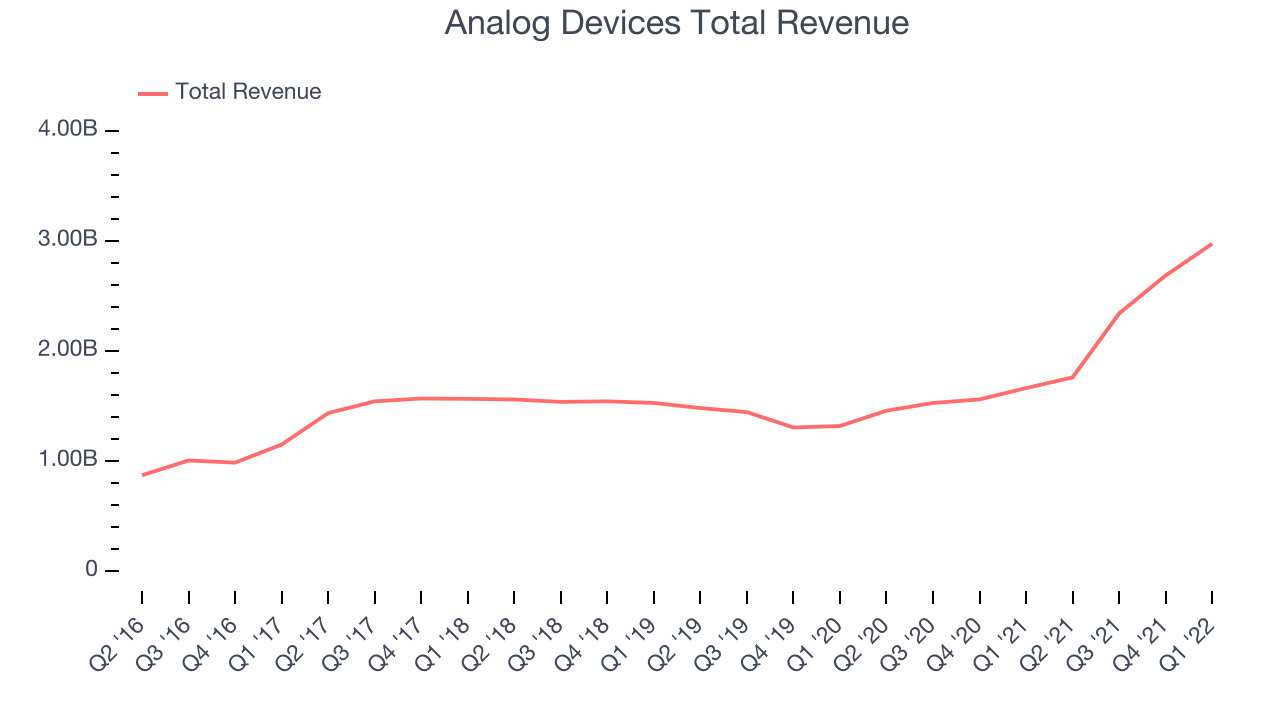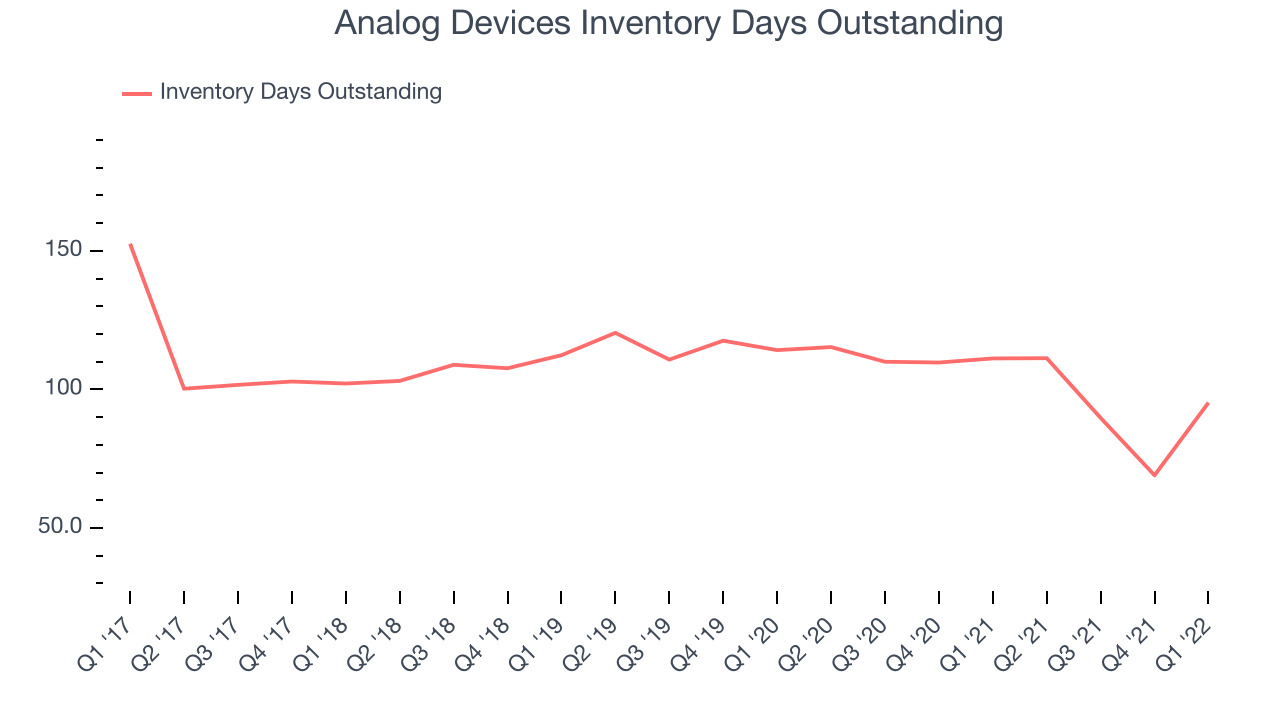Manufacturer of analog chips, Analog Devices (NASDAQ:ADI) announced better-than-expected results in the Q2 FY2022 quarter, with revenue up 78.8% year on year to $2.97 billion. On top of that, guidance for next quarter's revenue was surprisingly good, being $3.05 billion at the midpoint, 5.39% above what analysts were expecting. Analog Devices made a GAAP profit of $783.2 million, improving on its profit of $422.9 million, in the same quarter last year.
Is now the time to buy Analog Devices? Access our full analysis of the earnings results here, it's free.
Analog Devices (ADI) Q2 FY2022 Highlights:
- Revenue: $2.97 billion vs analyst estimates of $1.09 billion (4.81% beat)
- EPS (non-GAAP): $2.40 vs analyst estimates of $2.11 (13.6% beat)
- Revenue guidance for Q3 2022 is $3.05 billion at the midpoint, above analyst estimates of $2.89 billion
- Free cash flow of $1.1 billion, up 48% from previous quarter
- Inventory Days Outstanding: 95, up from 69 previous quarter
- Gross Margin (GAAP): 65.4%, down from 68.4% same quarter last year
“ADI delivered its fifth consecutive quarter of record revenue, illustrating the unprecedented demand for our technologies and our ability to increase output in a challenging supply backdrop. Top line strength combined with successful synergy execution enabled adjusted gross margin, operating margin and EPS to achieve new highs,” said Vincent Roche, CEO and Chair.
Founded by two MIT graduates, Ray Stata and Matthew Lorber in 1965, Analog Devices (NASDAQ:ADI) is one of the largest providers of high performance analog integrated circuits used mainly in industrial end markets, along with communications, autos, and consumer devices.
Demand for analog chips is generally linked to the overall level of economic growth, as analog chips serve as the building blocks of most electronic goods and equipment. The biggest secular growth drivers currently are the adoption of electric vehicles, 5G networks and Internet of Things connectivity, and demand for chips that reduce power consumption. Unlike digital chip designers, analog chip makers tend to produce the majority of their own chips, as analog chip production does not require expensive leading edge nodes. Less dependent on major secular growth drivers, analog product cycles are much longer, often 5-7 years.
Sales Growth
Analog Devices's revenue growth over the last three years has been solid, averaging 19.5% annually. But as you can see below, last year has been stronger for the company due to the acquisition of Maxim Integrated, growing from quarterly revenue of $1.66 billion to $2.97 billion. Semiconductors are a cyclical industry and long-term investors should be prepared for periods of high growth, followed by periods of revenue contractions (which can sometimes offer opportune times to buy).

This was a good quarter for Analog Devices with 78.8% revenue growth, beating analyst estimates by 4.81%. This marks 7 straight quarters of revenue growth, which means the current upcycle has had a good run, as a typical upcycle tends to be 8-10 quarters.
However, Analog Devices believes the growth is set to continue, and is guiding for revenue to grow 73.4% YoY next quarter, and Wall St analysts are estimating growth 24.8% over the next twelve months.
In volatile times like these we look for robust businesses with strong pricing power. Unknown to most investors, this company is one of the highest-quality software companies in the world, and their software products have been the default standard in critical industries for decades. The result is an impressive business that is up an incredible 18,152% since the IPO. You can find it on our platform for free.
Product Demand & Outstanding Inventory
Days Inventory Outstanding (DIO) are an important metric for chipmakers, as it reflects the capital intensity of the business and the cyclical nature of semiconductor supply and demand. In a tight supply environment, inventories tend to be stable, allowing chipmakers to exert pricing power. Steadily increasing DIO can be a warning sign that demand is weak, and if inventories continue to rise the company may have to downsize production.

This quarter, Analog Devices’s inventory days came in at 95, 10 days below the five year average, showing that despite the recent increase there is no indication of an excessive inventory buildup at the moment.
Key Takeaways from Analog Devices's Q2 Results
With a market capitalization of $85.7 billion, more than $1.73 billion in cash and with free cash flow over the last twelve months being positive, the company is in a very strong position to invest in growth.
We were impressed by how strongly Analog Devices outperformed analysts’ earnings expectations this quarter. And we were also glad to see the improvement in operating margin. On the other hand, it was less good to see the inventory levels increase and gross margin deteriorated a little. Overall, we think this was still a strong quarter, that should leave shareholders feeling very positive. The company is up 3.01% on the results and currently trades at $168.9 per share.
Analog Devices may have had a good quarter, so should you invest right now? It is important that you take into account its valuation and business qualities, as well as what happened in the latest quarter. We look at that in our actionable report which you can read here, it's free.
One way to find opportunities in the market is to watch for generational shifts in the economy. Almost every company is slowly finding itself becoming a technology company and facing cybersecurity risks and as a result, the demand for cloud-native cybersecurity is skyrocketing. This company is leading a massive technological shift in the industry and with revenue growth of 70% year on year and best-in-class SaaS metrics it should definitely be on your radar.
The author has no position in any of the stocks mentioned.
